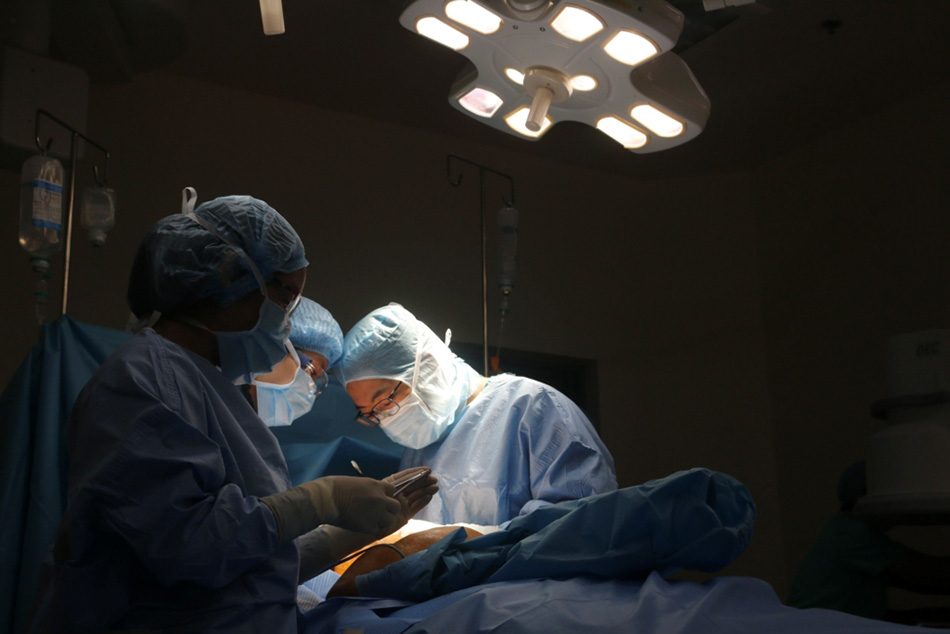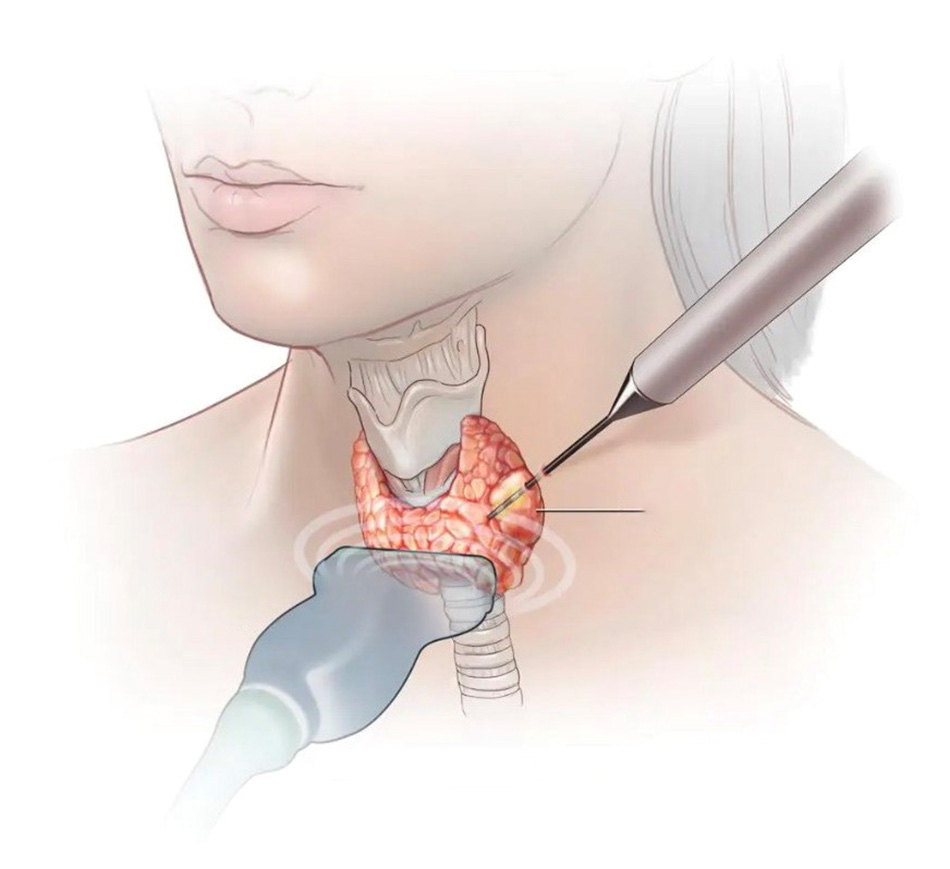Thyroid Nodule Ablation with High-Frequency Waves (RFA) is a minimally invasive technique that involves inserting a small needle into the nodule. This method is considered effective and safe, particularly for preserving thyroid function, thus ensuring a high quality of life for patients.
After completing the RFA procedure, patients need only to rest for about 30 minutes before they can go home and resume normal eating, activities, and work.
Benign Thyroid Nodules: When is Removal Necessary?
Thyroid nodules, also known as thyroid lumps or tumours, are solid or fluid-filled masses that form within the thyroid gland due to abnormal cell growth. According to statistics, thyroid nodules affect about 7% of the adult population, with women being five times more likely than men to develop them. These nodules are often difficult to detect with the naked eye and are primarily discovered through health screenings. Sometimes, patients visit doctors after noticing or feeling the nodules, which can sometimes cause aesthetic concerns in the neck region.
Many people fear that thyroid nodules may lead to thyroid cancer. However, according to Luong Ngoc Trung, MD, MSc, (Head of the Thoracic, Vascular & Endovascular Surgery Department at FV Hospital), most thyroid nodules are benign and not dangerous, with only a very small percentage potentially developing into malignant tumours.
When a thyroid nodule is detected, patients should not be overly fearful but should undergo regular check-ups and monitoring. Surgical removal of the thyroid nodule will be indicated by the doctor in cases where the nodule grows large enough to compress the neck nerves, cause hoarseness, coughing when swallowing, or difficulty in breathing. It is also necessary if the nodule grows significantly, occupying the entire thyroid gland and disrupting its function, or when the nodule becomes large enough to cause aesthetic concerns in the neck area. Additionally, there are toxic thyroid nodules, which, despite being small, become overactive and secrete excess thyroid hormones, leading to hyperthyroidism, these also require treatment.

Specialist doctor will evaluate the condition of the patient’s thyroid nodule to determine whether surgical removal is necessary.
To determine if a thyroid nodule requires surgical removal, patients need to be examined by a specialist doctor. Based on ultrasound results, the doctor will assess whether the size of the nodule is affecting nearby organs. Additionally, a biopsy will be performed to ensure the nodule is benign. According to Dr Trung “Medically, a benign thyroid nodule at the 15 mm threshold should be considered for surgery. Alternatively, nodules around 10-12 mm that cause complications by compressing adjacent structures, leading to protrusion and deformation of the neck and affecting aesthetics, should also be considered for treatment.”
The traditional methods for treating thyroid nodules involve open surgery or endoscopic surgery. Depending on whether the nodule is located in the right or left lobe or the isthmus, the doctor will remove the nodule or the entire thyroid lobe containing the nodule. This surgery has some limitations: it leaves scars and the patients face risks of infection, significant bleeding, and potential damage to the recurrent laryngeal nerve, causing hoarseness or even hypothyroidism after surgery.
Recently, the technique of destroying benign thyroid nodules using radiofrequency ablation (RFA) has emerged and is considered a minimally invasive treatment method that addresses the shortcomings of surgery. This technique has been officially implemented at the Thoracic, Vascular & Endovascular Surgery Department, FV Hospital, since early 2024. RFA is recommended as an alternative to conventional surgery for patients with large thyroid nodules causing aesthetic concerns, symptoms of oesophageal or tracheal compression such as difficulty swallowing, coughing, discomfort, or hyperthyroidism due to toxic nodules.
RFA Technique: Safe, aesthetic, and better preserves the thyroid gland
According to Dr Trung, the radiofrequency ablation (RFA) technique for thyroid nodule ablation offers numerous advantages over traditional surgical methods. “The RFA technique helps preserve the thyroid gland better than surgical procedures. It is a minimally invasive method, with only a small portion of the healthy thyroid tissue surrounding the nodule being destroyed by the heat from the radiofrequency waves. The remaining thyroid tissue is preserved, preventing patients from experiencing issues related to thyroid dysfunction,” Dr Trung explained.

Luong Ngoc Trung, MD, MSc and his team perform thyroid nodule treatment for patients.
“The radiofrequency ablation (RFA) technique for treating thyroid nodules is widely applied worldwide, with the United States also approving its regular use in managing thyroid nodules. Clinical trials in Italy and South Korea have shown that the volume of thyroid nodules shrinks by 50 to 80% within the first 6 months after RFA treatment, and related symptoms associated with thyroid nodules are significantly improved or even disappear,” said Luong Ngoc Trung, MD, MSc.

“The RFA technique delivers high-frequency waves into the thyroid nodule to destroy the thyroid tissue through a small needle,” Dr Luong Ngoc Trung explained.
To perform the thyroid nodule ablation technique using high-frequency waves, the doctor administers local anaesthesia around the patient’s thyroid gland. Then, ultrasound is used to accurately determine the position, size, and volume of the thyroid nodule before proceeding with the ablation using high-frequency waves under ultrasound guidance. The radiofrequency energy emitted from the needle tip will destroy the thyroid nodule. After the procedure, the patient only needs to rest for about 30 minutes before being able to go home, eat, resume normal activities, and work.
The RFA technique is indicated for solid thyroid nodules, it is not effective for treating fluid-filled nodules. For mixed nodules, the doctor will first aspirate the fluid before performing the ablation with high-frequency waves to achieve better treatment outcomes. Dr Trung explained “There are no absolute contraindications to this method; however, caution is needed when applying it to special cases such as pregnant women, patients with severe cardiovascular diseases, and patients with vocal cord paralysis on the contralateral side.”
RFA is considered a minimally invasive, safe, and effective solution for treating thyroid nodules, helping patients improve their quality of life. However, for large nodules, multiple ablation sessions may be required.
For more information about thyroid nodule ablation using high-frequency waves, please contact Thoracic, Vascular & Endovascular Surgery Department, FV Hospital at: (028) 35 11 33 33.



